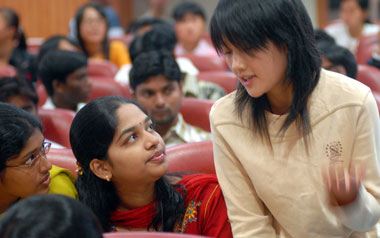About 1,200 years ago, a Chinese Buddhist monk named Xuan Zang came to Vellore in India to study Buddhism, a legend that became the classic "Journey to the West."
Today, more than 1,200 Chinese students are following the steps of Xuan Zang - but they are going to India to study IT, English, finance and commerce at a dozen Indian universities.
 |
|
A Chinese student talks with her Indian classmates during a course. Today, more than 1,200 Chinese students are going to India to study IT, English, finance and commerce at a dozen Indian universities. [CFP] |
In Tamil Nadu, located mid-way between two major Indian cities, Bangalore and Chennai, 414 Chinese students have formed the largest foreign community ever at the newly established college of the Vellore Institute of Technology (VIT).
Recently the Chinese Ambassador to India Zhang Yan brought a spiritual back-up for these students - a bronze statue of Confucius - to inaugurate a Chinese Language Study Center in VIT, the first of its kind in an Indian university.
"I am so happy to see such a large group of Chinese students in VIT and to realize that the number is still growing," Zhang told the students. "Relations between China and India have entered a fast track in recent years, and you can become the mini-ambassadors for China building friendship with Indian students."
Addressing a vast auditorium with hundreds of Indian and Chinese students, Zhang said that education and youth are the best way to build bilateral relations, as both represent the future.
It is obvious that the Indian campus is very similar to a Chinese one in both style and composition. That is one of the reasons Chinese students can quickly get accustomed to the environment, which is distinctly different from their home country in so many other ways.
Shao Subo, the first Chinese PhD student in the Business School at VIT, says that Indian colleges are good places to learn, because it is not possible to pass exams without mastering good English writing and speaking skills. The Indian schools also ask students to present independent ideas on theories instead of just memorizing formulas and texts.
A native of Hunan Province who came to India in 2006, Shao says Chinese students can learn a lot from their Indian counterparts, as the latter are among the brightest in the world and the most hardworking as well. He says that Chinese students must overcome the culture shock and learn to work very hard and very diligently in order to survive in India.
Li Ming, an IT student from Sichuan Province, says that she has learned a lot since coming to India one and a half years ago and has matured a lot living away from home.
She says her No. 1 concern after graduating next year with a degree from VIT is how to get a job. Her plan is to work for a Chinese company which has projects in India, because she can put what she learned here into better use in India than in China.
G. Viswanathan, the chancellor of VIT and former member of parliament of India, told the Chinese and Indian students that he was proud to be a pioneer in building a close relationship with China in education.
Viswanathan shared Ambassador Zhang's view that as two of the most ancient civilizations and fast-growing economies in the world, India and China should join hands in building a world for future generations.
He said that as far back as the 5th century, India already had an early center of learning similar to a university, the Takshashila, which attracted a lot of foreign students including Chinese who came to learn Buddhism.
The historic Nalanda University was yet another excellent example of the brilliance of India's ancient education system and its constant internationalism.
Viswanathan said his ideal is to build VIT into a modern-day Takshashila or Nalanda, and he chose China as a cooperative partner because China is bound to become the world's largest economy in future and India the third largest. With some 1,000 professors and 14,000 students, VIT has become a new star in India's colleges since its establishment in 1984, particularly the taking over of chancellor's seat by Viswanathan, says Rao, director of international relations at VIT.
Rao says he likes his Chinese students very much and has learnt how to help them overcome all kinds of their problems ranging from observing college disciplinary regulations to helping them find accommodation with Indian students and teachers.
"There are a lot of cultural differences between Chinese and Indian students, and sometimes there are disputes between some students with laboratory managers and teachers, but I know how to solve them," he says.
Sathya Moorthy, chairman of the Sino-India Education and Technology Alliance in Beijing, is the key promoter for the cooperative program between VIT and Chinese institutions engaged in sending Chinese students to India.
A Malaysian national of Indian ethnic origin, Moorthy has been working on the program since 2003. His latest program is to introduce the Chinese Language Study Center to VIT with support from the Chinese Ministry of Education and the Zhengzhou University, from China's Henan Province.
"I wish to make VIT a true center of Sino-Indian cooperation. I know the easiest way to build better relations between the two countries is through education," he says.
(Xinhua News Agency June 18, 2009)